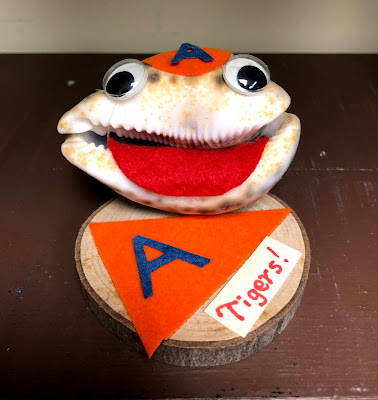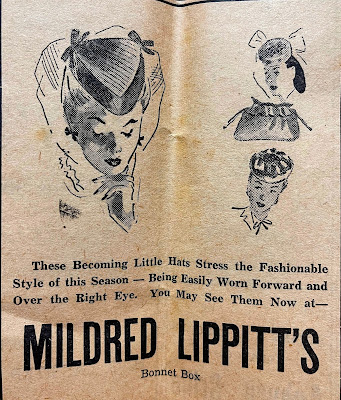I was recently sifting through a box of old newspapers that came from my paternal grandparents' house in Gadsden. I've written about them, Amos J. and Rosa Mae Wright, in a previous post and hope to do others in the future. This particular box of treasures contained mostly the front page section of many issues of the Gadsden Times published during World War II. I assume my grandmother saved them; she seemed to be the archivist of that couple. Naturally there is a lot of interesting war news, but the issues also have fascinating material from the Gadsden area and around the state and elsewhere. I imagine there are numerous possible blog posts buried there.....
But I digress. I also came across this random issue of the Auburn Plainsman, the university's student newspaper. My Dad, Amos J. Jr., was enrolled at Alabama Polytechnic Institute at this time, before a couple of years in the Navy just after the war ended. I didn't find too much of interest except some fascinating advertisements, so here we are.
The Plainsman had begun publication in 1922; you can find past issues here. The issue I found was six pages; the sheet with pages three and four is missing. I'm not sure why this random issue was saved, but perhaps Dad brought it home as a sample to show his mother while he was enrolled at Auburn.
I've made a number of comments below the ads, with help from these sources:
Ralph Draughon, Jr, et al. Lost Auburn: A Village Remembered in Period Photographs [2012]
Sam Hendrix, Auburn: A History in Street Names [2021]
The first Tiger Theatre opened in 1925 and closed in the summer 1928 so the next bigger one could be built. The new building had over 700 seats and closed on April 26, 1984. I seem to remember seeing Who'll Stop the Rain? there, the 1978 film with Nick Nolte and Tuesday Weld. The film was based on Robert Stone's 1974 novel Dog Soldiers, which is well worth reading.
Hat Check Honey was released on March 10, 1944; many films took longer to make their way around in the country in those days. The Very Thought of You came out on October 20, 1944. The Pearl of Death, released on August 1, 1944, was a Sherlock Holmes film so I probably would have gone to see that one.
The Windmill operated from the 1930s until 1951, when its beer license was revoked for selling to minors and other offenses. In the 1930s and early 1940s it was the only place in the Auburn area to obtain legal alcohol. The place was frequented by veterans in school at Auburn; no co-eds were allowed. The entrance was a faux windmill. The business was really a gas station with a few booths and tables inside.
I did not find any information on the Varsity.
Auburn Grille advertised as "an institution within itself." The Greek immigrants John and Lucas Gazes operated the Grille and Roy's Place. The Grille was the first restaurant with air conditioning in Lee County and was named for the Auburn automobile, manufactured in Auburn, Indiana, from 1900 until 1937. Their father Emmanuel Gazes operated the Auburn Cafe from 1907 until 1921. The family was also involved in various other eating places, including what became the War Eagle Supper Club.
Some of these places such as Roy's and the Windmill operated outside city limits since according to state law at the time alcohol could not be served inside the limits.
War Eagle Theater was part of the Martin chain & the first chain theater in Auburn. This one must have been known as Martin Theater and later renamed.
By 1982 there were 300 Martin Theaters in the southeastern U.S. In that year the chain's owner, Fuqua Industries sold the chain to Carmike Cinemas. In 2016 Carmike was purchased by AMC Theatres.
This particular Martin opened on August 19, 1948 and closed in 1985. In October 1970 it hosted the first Alabama showing of I Walk the Line, based on the novel An Exile by Madison Jones [1925-2012], long-time faculty member at AU.
One of the films showing that I especially note and have enjoyed was To Have and Have Not, released in October 1944 and starring Humphrey Bogart and Lauren Bacall. The movie was based on Ernest Hemingway's 1937 novel.
"Chief" Shine provided the first rental car service in Auburn.
I did not find anything about this establishment, even in a general Google search.

















































